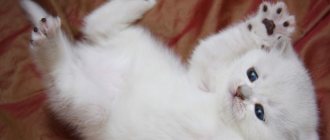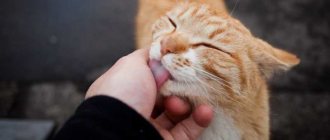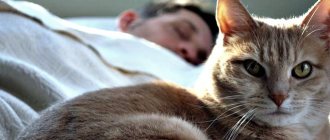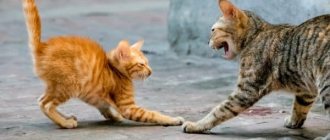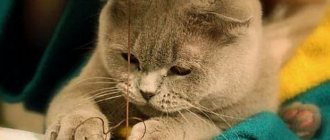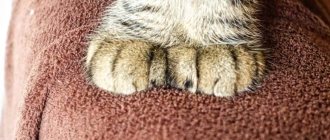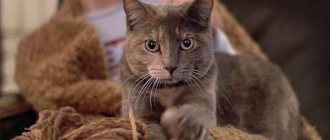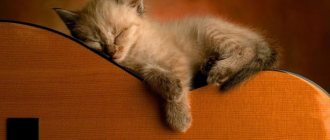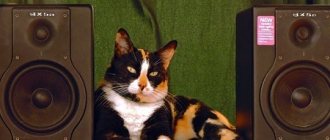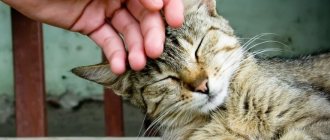It's not entirely clear why cats purr or even how they do it, but you can usually expect your favorite feline to purr when he's feeling content. Purrs are common in cats when they are petted, cuddled in a lap, or sunbathed by a window. Some cats purr simply because they enjoy it. However, cats sometimes purr when they feel bad or in pain.
Therefore, you must pay attention to your cat's mood and physical behavior to determine why she is purring. Moreover, some cats never purr their entire lives, and some cats that once purred stop purring. But why is this? Let's look at why your cat may not purr and discuss what you can do about it.
They just don't like it
Sometimes cats don't purr because they don't want to. But just because your cat isn't purring doesn't mean she's unhappy. It just means they don't want to purr. If your cat usually purrs when you pet her but doesn't purr from time to time, chances are she just won't want to purr at those times. However, if your cat stops purring altogether when you pet her, this could be another reason for the silence.
Image Credit: Paul Hanaoka, Unsplash
Physiological causes of sound
I wonder why cats meow, what motivates them to make such a sound. Zoologists claim that this is determined by the characteristics of the cat’s body:
- The cerebral cortex sends signals to your pet's vocal cords. Electrical impulses force the muscles to contract, thereby causing vibration in the ligaments. If during this process the pet opens its mouth, then a sound appears: “meow,” that is, the cat meows, and if not, then it purrs. Purring occurs due to the bones located under the cat's tongue. During the vibration that occurs in the vocal cords, resonance occurs and a sound comes out, which everyone calls “purring.” In veterinary medicine, these unique bones are called “false vocal cords.”
- Another version of why a cat purrs is a special flow of air that enters the lungs. At the same time, cats purr both when inhaling and exhaling.
- The next assumption is that cats can force blood to circulate through arteries and veins in a special way, resulting in vibration, which is converted into sound in the skull.
- During purring, sound vibration affects the cat's muscles, that is, in the process of purring, not only the muscle mass increases, but also bone tissue grows. Also, for lazy people like cats, purring replaces body exercise.
Interestingly, large relatives of cats are not able to make such a mesmerizing sound, because their light bones are covered with cartilage.
They are sick or injured
A cat may purr to relieve stress when it is sick or injured, but more often cats will stop purring altogether until they feel better. Injury can affect your cat's ability to purr, even if she wants to. Damaged nails, dental infections, and even insect bites can cause injury. Many types of illnesses, from major infections to food poisoning, can cause a cat to stop purring.
If your cat isn't purring due to injury or illness, you may notice other signs of discomfort such as whining, vomiting, and lethargy. You can check for injuries by lightly rubbing your cat's body to see if any area is sensitive to touch. Also examine their mouth and teeth. Any signs of illness or injury associated with a lack of purring should be brought to the attention of a veterinarian immediately.
Why do cats purr?
Having determined the mechanism of origin of rumbling, we will try to understand the reasons for its occurrence. Research by cat behavior specialists Karen Overall and Elisabeth von Muggenthaler will help us with this.
Conventionally, the reasons for purring can be divided into two groups: positive and alarming .
Positive
Approval or gratitude
The reason why cats purr like a tractor may be the positive emotions the animal has experienced, such as gratitude and approval of the owner’s actions.
We hear the cat purring when he receives affection from his owner. At such moments, the animal’s body language speaks of its complete satisfaction. The tail lies motionless, and the eyes are slightly open.
Complete relaxation of the animal is also the answer to the question of why cats knead their paws and purr. At such moments, the animal manifests an instinct called the “milk step” . This is a reference to childhood, when, as a small kitten, the pet would trample its mother's nipple to increase the flow of milk.
Approval of an action can be directed not only at the person. When cats live in a group, they communicate to each other through rumbling that they are doing the right thing . For example, cats help each other wash themselves and get ready for bed. By purring they indicate their affection for their fellow creatures.
Hunting instinct
prey nearby, behind the glass . This reaction occurs due to the excitement of the animal.
A specific purring also occurs after a successful hunt, when the cat has reached its goal.
The sounds produced will be lower and less intense.
Method of communication
You can often observe a situation where cats respond by rumbling to dissatisfaction or praise shown by a person. How to understand why a cat constantly purrs, and what does it mean in a particular situation?
Using purring, cats can talk to humans. However, to understand them, you need to know something about their body language.
For example, when a cat invites you to play, a raised tail .
But if the ears are pressed to the head and the eyes are like those of the cat from Shrek, then it is better not to disturb the kitty for now .
The cat shows complete trust when it lies on its back and exposes its belly . The belly is a special place for animals. And they show it only to those whom they really trust in moments of relaxation.
When you are talking to a cat, and he is just in the mood to communicate with you, the purring will be irregular and intermittent.
To attract attention
Purring also signals that the cat wants to pay attention to something. For example, the owner overslept, and the cat is trying to wake him up . This explains why cats purr and paw when the alarm clock rings, but the owner continues to sleep. Or when the cat is hungry and the owner goes to the refrigerator.
Babies master the skill of conversation from the second day of birth. This allows you to attract mom's attention when there is potential danger nearby.
Experiments have shown that the sound produced when purring, its timbre and intensity depend on the situation .
When stroking, cats make low, velvety, dull sounds. In a situation where a cat is trying to lure out its prey, the sound of rumbling will be louder, similar to the crying of a baby.
For treatment
Cats heal – a proven fact. The fact is that a cat purrs at a frequency of 25-150 Hz. These same frequencies are used by doctors when conducting physical therapy .
It has been noted that cats begin to purr more intensely and for a longer time after falling from a height, fights, childbirth and operations.
The sound waves emitted by the animal resemble hardware ultrasound in their effect. They accelerate the process of tissue regeneration in the body during fractures, sprains, after operations and the formation of edema.
In their sleep, cats purr to maintain physical health in the absence of the opportunity to walk outside for a long time and with a low level of physical activity.
Cats are no strangers to empathy , so when they see a sick relative or family member for whom they show sympathy, the cat begins to purr intensely, rub against the patient, stomp on him and go to sleep on the problem areas. After just a few minutes of “cat songs,” people with headaches feel an improvement and a decrease in body aches and fever.
According to studies, a cat's purring reduces stress levels in humans , normalizes blood pressure and pulse, which reduces the likelihood of developing cardiovascular diseases by almost a third. Stroking a cat is akin to meditation. This calms the human nervous system and stimulates the brain to produce the happiness hormone oxytocin.
Sexual hunting
Many owners wonder why cats purr loudly, demand to be petted, and then bite.
Unsterilized cats can roll on the floor on their backs, purr and attract the attention of the male. In this case, the animal also exhibits other signs characteristic of this period. During sexual heat, the timbre, intensity and tonality of the purring will differ from the usual.
Negative
Stress
One of the reasons why a cat purrs constantly may be stress . It can be caused by moving, a change of environment, a trip to the veterinarian, labor, for example.
After a fight with a larger predator or relative, seals also often begin to experience a feeling of anxiety and reproduce rumbling.
Disease
It is believed that a cat that constantly purrs has some kind of disease. Unfortunately, there is no reliable information on this matter - usually the presence or absence of purring reflects the psychological state of the animal, but not the physical one.
That is, the fact of purring does not at all indicate the presence or absence of a disease.
For example, a cat may purr when he feels good in your company, but at the same time he will be absolutely healthy. Or vice versa, he may not purr and have a disease. If you are concerned about the behavior of your animals and do not know why cats purr like a tractor all the time, and their behavior is not related to the above reasons, you should consult with a zoopsychologist.
They're just getting old
Sometimes cats lose energy as they age. Instead, they prefer to use their energy for eating and playing. Even though they don't purr, older cats can be just as happy as younger ones. They simply may not have the energy or means to show you their appreciation and happiness as they used to.
Image Credit: Sleepy Cat, Unsplash
Benefits of “cat songs”
- normalize the emotional state, which is especially useful for owners with nervous disorders;
- strengthen bone tissue and reduce pain;
- improve blood circulation in the brain;
- lower blood pressure or pulse that is too high;
- enhance the regeneration of tissues of the gastrointestinal tract;
- reduce the likelihood of stroke and heart attack.
People who live with furry pets live 4.5 years longer than those who do not have pets. There is also a relationship with allergen resistance. Children who live with a mustachioed pet from birth are less susceptible to respiratory diseases and rarely suffer from asthma.
What to do
There is little you can do about the lack of purring other than provide encouragement to your cat if necessary. If they don't seem normal, you should make an appointment with your veterinarian to see if anything can be done to make them feel better. They may start purring again once they feel like themselves. If your cat just doesn't want to purr, all you can do is love her and reward her with petting and cuddling. If they get old, you may just have to live with the lack of purring from now on, but you can still expect the love and attention you've always received.
Cat emotions and rumbling
There are many emotional states that cause a cat to purr.
The most basic ones are:
- Gratitude. A small pet purrs with pleasure from affection, a treat received, or from being close to its owner.
- Relaxation before bed. When a cat feels safe, relaxingly dozes before bed in the sun or in the arms of its owner, it purrs with pleasure.
- Dialogue between a cat and kittens. The cat, approaching the kittens, purrs, calming them down. In the wild, kittens were often left alone while their parents hunted, and thus the adults warned them that there was nothing to be afraid of.
- Self-medication and treatment. If the cat is sick or one of the pets is sick, it stabilizes the metabolism and blood circulation process due to vibrations. At these moments it is better not to touch the animal.
- Hunting interest. A cat may make purring sounds when playing or watching “game.” This is how she shows her interest.
- Fear and aggression. Many people have watched cats purr before a fight. This is how cats express their dissatisfaction and readiness to attack.
In different situations and different emotional states of the pet, the rumbling has a different tone.
When communicating with other animals, a cat may purr quietly, which indicates its trust. If a cat purrs loudly when meeting other cats, then it shows a leadership position and a readiness to attack. Sometimes purring is a request for mercy if the animal understands that it is weaker than its opponent.
Final thoughts
Everyone loves to hear their cat purr. The sound and sensation of purring usually confirms the fact that they are happy. But just because your cat isn't purring doesn't mean you're doing anything wrong or that she's unhappy about anything. Watch for signs of trouble, but if you don't see any, chances are your cat just isn't interested. How often does your cat purr and do you notice that she doesn't purr when you expect her to? Tell us about your experience by leaving us a comment!
Posted by Christian Adams An American expat living in Metro Manila, Philippines for over a decade, Christian is a lifelong cat lover and the proud father of two rescue cats, Trixie and Chloe. Both girls used to be among the crowds of homeless people who roam the cities and countryside. Three-year-old Trixie was rescued from a litter found under a neighbor's porch, and two-year-old Chloe was brought home by Christian's young son, Henry, who discovered the crying kitten in the parking lot.
Can purring cure a person?
Cat “music,” if not a complete cure, can significantly speed up recovery. Purring with a frequency of up to 140 hertz promotes the healing of various injuries. When bones and tendons are damaged, the pain subsides and the tissues slowly recover. If a person suffers from arthrosis, osteochondrosis or radiculitis, then a cat will help; if a person has ailments of internal organs (or systems), a cat will help.
Purring has a positive effect on the nervous system and calms the general condition of the body, so purr therapy is recommended for use in cases of stress, insomnia, rehabilitation of drug addicts and alcoholics (purring reduces withdrawal symptoms). In addition, such vibrations help improve blood circulation, normalize blood pressure and heartbeat, alleviate symptoms of gastrointestinal disorders (colitis, flatulence, gastritis, stomach ulcers, etc.), increase immunity - people who have cats are less likely to get colds diseases.
It is not necessary to ask the animal to lie down on the sore spot - often cats themselves detect the source of pain
Purring is especially useful at the moment when the cat is doing a “claw massage.” Thus, vibration, uniform sound and the effect of acupuncture have the greatest beneficial effect on human health.
My cat happily lies/sits on the chest (or back) of any family member. She rolls her eyes, massages and purrs. Each such session can last up to half an hour. After this, Khosya falls asleep. As a rule, the one on whom she was lying or sitting also falls asleep.
The most purring breeds
There is no exact data on which cats purr louder and more often than others. It depends on the character and individual characteristics of the four-legged animal. But, since purring is one of the means of communication for cats, it can be assumed that sociable cats purr more often. The most affectionate cat breeds:
Whether a cat will purr and caress depends not so much on the breed, but on the attitude of the owner. A kind and affectionate pet will grow up in a loving, caring family.
Reference! The British cat Merlin entered the Guinness Book of Records for the loudest purr at 67.8 dB.
Cats purr in different sounds, depending on the reasons. If you listen to your pet, you can learn to understand him much better. This will not only make the cat happier, but also strengthen the bond between the animal and its owner.
Cat massage
There are many guesses why the pet purrs and tramples its owner with its paws. Here are some of them:
- Memories of childhood, or “milk step” - kittens knead their mother with their paws while feeding to quickly obtain milk. This brings them pleasure and is associated in adults with a feeling of comfort, satiety and security.
- Prepares a comfortable place to sleep - tramples the surface on which you are going to sleep for the greatest comfort. The owner's knees may well be suitable for this purpose.
- Gratitude - in this way one can say “thank you” for delicious food, warm shelter, tenderness and affection.
- Therapeutic massage is a common theory that this is how a cat treats its owner from ailments.
- Stress relief – by purring and moving their paws, cats lift their spirits, relax and calm down.
- Unfulfilled sexual instinct - one theory says that if an animal does not have a mate, it may show unambiguous interest.
- Marks its property - cats have glands on their paw pads that secrete a secretion. This is one of the ways to convey to other animals that a person belongs to him.
- Showing trust and love - the pet shows its owner its location, favor, openness and trust. Emphasizes your closeness with a person.
This massage soothes, relaxes and helps relieve stress. But what if claws are used? You can lightly press the cat towards you so that he lies down and stops trampling. You should not scold or drive out an animal if its trust and peace of mind are valuable. It’s better to just put a blanket or pillow on your knees in advance.
Reference! A cat will reflexively retract its claws if you stroke the top of its paws.
The effect of a cat's purring on humans
While it is undeniable that a cat's purrs calm us down, calm us down and make us feel good, their effects don't stop there!
Indeed, cat purring has recently been recognized as having therapeutic benefits for men. This is what some call purr therapy.
In fact, a cat's purring can reduce stress, combat insomnia, and calm anxiety. Other research, for example, is currently exploring the power of purring on bones to speed up bone healing.
When is a Purring Therapy Session Reimbursed by Social Security?
What you didn't know about purring
- Are cats afraid of water? But the sound of its flow fascinates them! The purring of a cat can be stopped by the sound of flowing water.
- Cats are good teachers. It turns out that there was a case when a small dog made sounds similar to purring. It turned out that the puppy was raised and lived in a cat family.
- The ability to purr is given to cats from birth. They do it well from the first days of life.
- The ability to purr is used between the tails for communication. This is how they show each other friendliness or show aggression. And the difference lies in timbre, rhythm, intonation and vibration volume.
- There is “purring therapy” which was developed by British specialists. This therapy is aimed at pain relief. Scientists have proven that this is exactly the effect that prolonged purring has on the human body.
- The calming “songs” of cats trigger special biochemical reactions in the human body and have a relaxing effect on us. They can lull you to sleep, relieve nervous tension and give you a feeling of euphoria.
- With the help of purring, cats can establish emotional contact with people and even take on other people’s pain...
